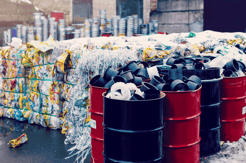The US federal Occupational Safety and Health Administration (OSHA) has published its annual list of the “Top 10 Most Frequently Cited Standards” for fiscal year (FY) 2021. The tabulation covers October 1, 2020 through September 30, 2021; OSHA delays its annual publication to allow time for inspections during a fiscal year to produce citations if appropriate. (I wrote about OSHA inspection procedures and priorities HERE). The remainder of this note summarizes the new list.
Read MoreAudit, Compliance and Risk Blog
Jon Elliott
Recent Posts
Tags: Health & Safety, OSHA, Workplace violence, violations, safety violations
Washington enforcing summertime heat and wildfire protection rules
Posted by Jon Elliott on Mon, Jul 18, 2022
This summer is again bringing record-breaking heat to parts of North America. It's time to remember that outdoor work in the summer sun can lead to heat illness, as can indoor work in spaces that aren’t sufficiently insulated or cooled. It’s also time to consider the possible impacts of local or regional wildfires on workplace air quality. Washington state provides useful benchmarks for these considerations, through rules administered every summer by the Department of Labor & Industries’ (L&I’s) Division of Occupational Safety and Health. The remainder of this note summarizes those requirements.
Read MoreTags: Wildfire, Heat Wave, Heat, Be Heat Smart, heat illness, Washington
Circuit Court sends Roundup pesticide review back to EPA for another try
Posted by Jon Elliott on Mon, Jul 11, 2022
On June 17, the Ninth Circuit (federal) Court of Appeals issued an important ruling on national pesticide regulation, directed at the chemical glyphosate, which is the active ingredient in the ubiquitous weedkiller Roundup (originally marketed by Monsanto, which was bought by Bayer in 2018). The order remands to the Environmental Protection Agency (EPA) the agency’s determination that glyphosate does not pose “any unreasonable risk to man or the environment,” citing evidence that such risks may indeed be present. The case, Natural Resources Defense Council v. EPA, interprets and applies the Federal Insecticide, Fungicide and Rodenticide Act (FIFRA). This decision is the latest step in controversies dating to 2009, when EPA began its latest FIFRA hazard review and reregistration determination for glyphosate.
Read MoreTags: EPA, FIFRA, pesticides
On June 20, 2022, the government of Canada published “Single-use Plastics Prohibition Regulations”, which will ban the manufacture and importation of most single-use plastics effective December 20, 2022, with some delayed deadlines to December 20, 2023. Bans on sale will phase in between December 20, 2023 and December 20, 2025. These rules are an important part of national efforts to reduce the manufacture and use of plastics, in order to reduce both resources used to manufacture them, and pollution when they are disposed or discarded. These new regulations are the most far-reaching of global efforts to date (as a narrower example, I wrote about California’s Microplastics Policy HERE). The remainder of this note summarizes the new Canadian regulations.
Read MoreCalifornia again considering requirements for workplace violence prevention
Posted by Jon Elliott on Mon, Jun 27, 2022
On May 22, California’s Division of Occupational Safety and Health (DOSH, but generally referred to as “Cal/OSHA”) issued its latest revised discussion draft of a regulatory standard mandating workplace violence prevention (WVP) steps for employers in “general industry” (potential 8 CCR 3343). This draft revives an effort that began in 2017, when the California Occupational Safety and Health Standards Board (OSHSB) responded to a schoolteacher’s petition that the state enact a WVP standard for educational settings by agreeing to consider one for all settings not covered by its standard for WVP in healthcare settings (which I wrote about HERE). The remainder of this note discusses the latest draft.
Read MoreFederal Distributing Corporations Report Expanding Board Diversity
Posted by Jon Elliott on Tue, Jun 21, 2022
Beginning in 2020, the Canada Business Corporation Act (CBCA) requires federal distributing companies to disclose annually the diversity in their boards and senior management. (CBCA s. 172.1). Disclosures are made to shareholders at annual meetings, and in filings with Corporations Canada. Corporations Canada has now published its review of filings covering calendar year 2021, citing the latest information and comparing with 2020 reports to assess initial progress.
Read MoreTags: Labour & Employment, CBCA, Canada, Directors Liability, CBCR
Department of Justice Reviving Use of Supplemental Environmental Project Agreements
Posted by Jon Elliott on Mon, Jun 13, 2022
On May 12, 2022, the US Department of Justice (DOJ) published an interim final rule that revokes a Trump-era prohibition against its attorneys’ use of payments to third parties, including via “supplemental environmental projects (SEPs)”, in settlements with violators of federal environmental laws. (I discussed Trump Administration policies several times, most recently HERE). In these cases, DOJ acts as the attorney for the agencies, such as the Environmental Protection Agency (EPA), that enforce laws and regulations allegedly violated. This rule change would codify policy changes presented in a memorandum from Attorney General Merrick Garland to US attorneys. This change is designed to restore flexibility to DOJ’s US attorneys to trade penalty dollars for more rapid commitments by wrongdoers to undertake actions to offset harms caused by their violations.
Read MoreTags: EPA, DOJ, SEP, Environment, Climate
California continues temporary requirements for COVID vaccination and testing
Posted by Jon Elliott on Mon, Jun 06, 2022
As public and occupational health agencies around the world continuously reevaluating their responses to the developing COVID-19 pandemic, California has again weighed in on the side of continuing formal controls. Effective May 5, 2022, California has revised and extended its COVID-19 Prevention Emergency Temporary Standard (ETS) until January 1, 2023. (I wrote about the most recent previous iteration adopted in February HERE). The ETS is presented as 5 rules, which are administered by California’s Division of Occupational Safety and Health (DOSH, but universally called Cal/OSHA). The remainder of this note summarizes these revised standards, which appear in Title 8 of the California Code of Regulations (CCR):
Read MoreTags: Health & Safety, OSHA, Safety and Health at Work, Covid-19, workplace safety, California, Vaccination, Healthcare

On May 4, 2022, the US Environmental Protection Agency (EPA) published notice of a proposed consent decree in litigation brought by the environmental group Center for Biological Diversity (CBD). EPA proposes to issue a decision responding to a petition filed by CBD in 2014, about whether to list discarded polyvinyl chloride (PVC) as hazardous waste under the Resource Conservation and Recovery Act (RCRA). CBD filed the suit early in 2021, after EPA had taken no action on its petition for seven years, claiming that the agency’s inaction violated a duty to act. EPA is now ready to commit to issue a proposed decision no later than January 20, 2023, and a final decision by April 12, 2024.
Read More
Tags: EPA, Environment, plastics, PVC
OSHA launches National Emphasis Program to address workplace heat hazards
Posted by Jon Elliott on Tue, May 24, 2022
On April 8, 2022, the US federal Occupational Safety and Health Administration (OSHA) established a National Emphasis Program (NEP) to focus enforcement resources on “Outdoor and Indoor Heat-Related Hazards.” The NEP is OSHA’s latest step to manage and reduce heat illness in workplaces. Earlier actions include “Inspection Guidance for Heat-Related Hazards” on September 1, 2021 (I wrote about it HERE), and an “advanced notice of proposed rulemaking (ANPRM)” on these topics issued on October 27, 2021 (which I wrote about HERE). The remainder of this note summarizes the NEP.
Read MoreTags: OSHA, workplace safety, Heat Wave, Heat









